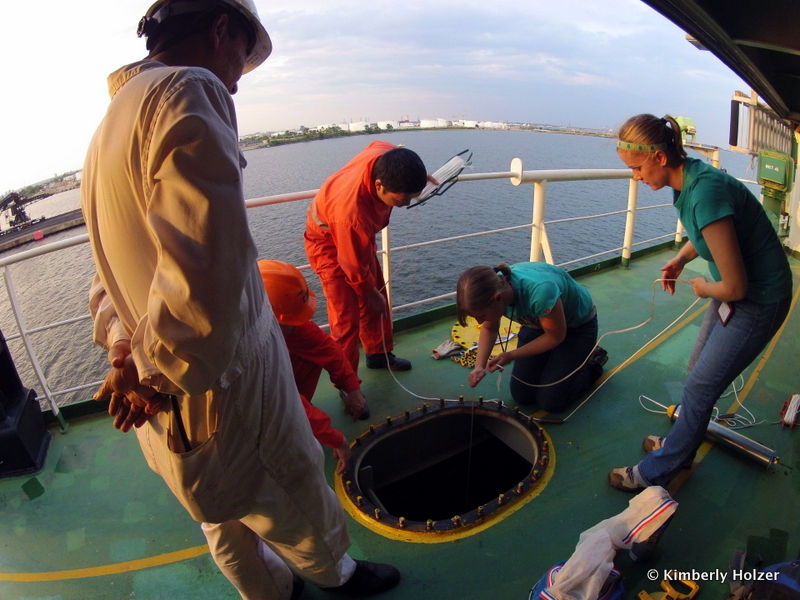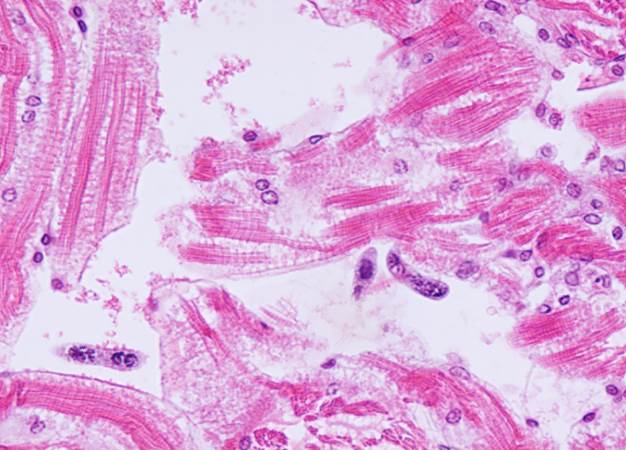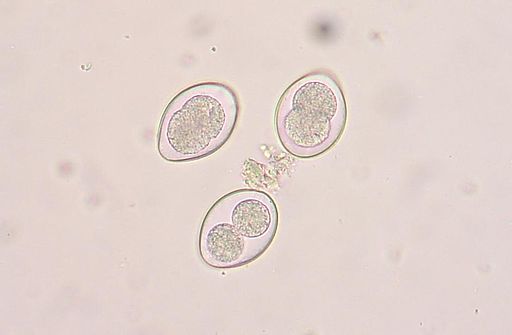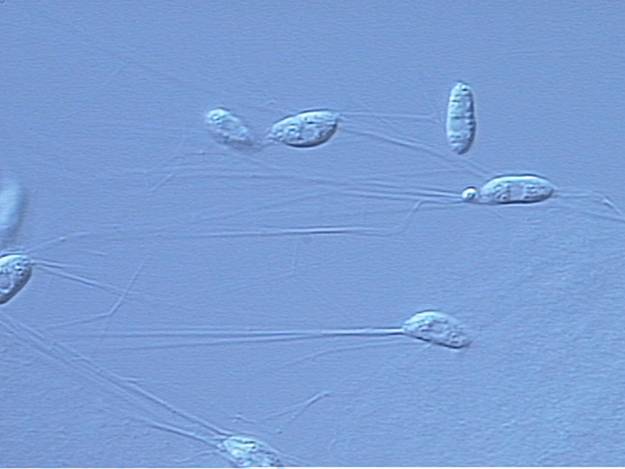Ships play a major role in the transport of goods needed to support today’s global marketplace. But products for human consumption are not the only things being transported by these ships – some marine species are hitching a ride on these ships too! These hitchhikers are being sucked up in the ship’s ballast tanks or attaching to the ship’s hull and are able to travel vast distances with the ship. Those that survive the journey can settle and thrive in regions where they never previously existed. When this happens, they can cause huge problems in their new home.
When marine parasites are transported to new locations, they can have negative impacts on naive host populations, likely because the new host species does not know how to fight off the introduced parasite. In some cases, introduced parasites can kill many individuals within a population, greatly impacting the surrounding ecosystem. Marine parasites spread mainly through unintentional movement of infected hosts, such as when hosts are moved around for aquaculture or the aquarium trade. But, many marine parasites have free-living stages that survive in the water column, some for long periods of time, and could be transported in ship’s ballast water. The question that we asked was, what, if any, protistan (or single celled) marine parasites are present in ballast water?

For this study, a group of researchers at the Smithsonian (Drs. Kimberly Holzer, Jenny Carney, Robert Fleischer, and Gregory Ruiz) and I collected ballast water from a number of different ships that arrived in the Chesapeake Bay (Virginia and Maryland, US) from Western European, Scandinavian, and Eastern Canadian ports. We used a new technique to assess the diversity of single celled organisms in the ballast water. We did a metagenomic analysis of the protists in ballast water by using next generation sequencing to generate 50,817 sequences. Metagenomic analysis detects genetic material directly from an environmental sample. These sequences were then used to identify the organisms present by comparing the sequences we generated to sequences from known protists. This study is the first time that this technique has been used to look at protists, or any microbe, in ballast water and is the first comprehensive look at protistan parasites in ballast water.
Using these sequences, we identified many different protistan groups that had previously been reported in ballast water including dinoflagellates and diatoms. However, we also identified a number of taxa not previously reported from ballast water including cercozoans, choanoflagellates, and haptophytes.
In addition to getting a broad overview of what protists were in the ballast water samples, we did additional analyses on five major groups containing parasites that were identified with these sequences. The five major groups containing parasitic organisms include the Syndiniales, Perkinsids, Coccidia, Labyrinthulomycetes, and Ichthyosporeans. Okay, so parasites have really weird names, but let me tell you a little bit about each of these groups to explain why it’s so important that we know these parasites are in ballast water.

Syndiniales
The Syndiniales are a group of parasitic dinoflagellates that are known to infect crustaceans (crabs, shrimp, barnacles, etc.), ciliates, fish and their eggs, and other dinoflagellates. Recent scientific studies have shown that the species diversity within this group is extremely high and much of the diversity of these organisms includes unnamed species that we know nothing about. Though we couldn’t conclusively identify any species with our sequences (mainly because so many species have not been properly identified), our data showed a great diversity of syndiniales in ballast water, with the number and type of organisms within this group varying greatly by ship. Thus, ballast water is clearly a way that these organisms move great distances. Additionally, many of the same type of syndinid were identified in multiple ships, allowing the potential for multiple introductions and increasing the chances of survival in the new place.
Perkinsids
Perkinsids are protistan parasites that belong to their own phyla and are closely related to parasitic dinoflagellates, even though they aren’t dinoflagellates. Within this phyla are only two genera. The first genus, Perkinsus, includes parasites that infect many different bivalve (clams, oysters, etc.) species. Some species within the genus Perkinsus have caused huge problems by infecting and killing large numbers of commercially important bivalves such as the eastern oyster (Crassostrea virginica), the Manila clam (Venerupis philippinarum), and the Pacific oyster (Crassostrea gigas), just to name a few. Much less is known about the second genus, Parvilucifera, which includes parasites that infect dinoflagellates.
Only one perkinsid was found from the ballast water of a single ship, the parasite Parvilucifera sinerae, a parasite that is known to infect many different dinoflagellate species. This makes sense given that we also detected a large number of dinoflagellate species in the ballast water sampled. Finding P. sinerae is interesting and important mainly because this parasite is a generalist parasite, meaning that it isn’t too picky about what species it infects and is more likely to be able to find appropriate hosts if transported to a new area.

Coccidia
Coccidian parasites infect a wide range of animals including humans, dogs, cats, and birds. We detected the coccidian parasite Cryptosporidium struthionis, which is known to infect poultry. Given that the coccidian oocysts, the stage of the parasite that exits the host and is transmitted to a new host, can survive for long periods of time in the environment, it is likely that the oocyst would be capable of surviving a trip in ballast water.
Ichthyosporeans
Ichthyosporeans are an interesting group of ancient protists that occur at the “animal-fungi” divide in the tree of life. Ichthyosporeans, once thought to infect only fishes, are now known to infect a wide range of hosts, including fish, invertebrates, amphibians, birds and mammals. Organisms in this group also represent a range of symbiotic interactions, from mutualists (organisms that live together in a mutually beneficial way) to parasites, with all known species having been found in some kind of symbiotic relationship. All of the Ichthyosporeans we detected represented novel lineages, meaning that we could not identify any particular species of Ichthyosporean in ballast water, probably because there are very few sequences that have been generated from previously identified Ichthyosporeans.
There are three taxonomic groups within the Labyrinthulomycetes: aplanochytrids, labyrinthulids, and thraustochytrids. We detected members of all three groups within the Labyrinthulomycetes in ballast water and a few of these could be identified as parasitic species. For example, some sequences were identified as belonging to Thraustochytrium caudivorum, a known parasite of the marine flatworm, Macrostomum lignano, and Labyrinthuloides haliotidis, a pathogen of juvenile abalone, Haliotis kamtschatkana and H. rufescens. Many additional lineages were detected that we could not identify. Given the important ecological roles of the Labyrinthulomycetes and the sheer richness of organisms detected, ballast water is likely an important mechanism for the spread of these organisms.

Labyrinthulomycetes
Labyrinthulomycetes, commonly referred to as slime nets, are generally believed to be important marine decomposers, breaking down dead plant and animal matter. Additionally, some Labyrinthulomycetes are infamous for causing diseases, including the labyrinthulid Labyrinthula zosterae, the agent of eelgrass wasting disease. This disease has been blamed as a major reason for the massive decline of eelgrass beds around the world, including Chesapeake Bay.
Conclusions
In conclusion, this study provides the first documentation of a wide range of protists, including parasites, in the ballast water of ships. These results raise many intriguing questions about the potential influence of ship traffic on spreading or contributing to emerging infectious diseases in the oceans, which is an ongoing problem worldwide. This research also highlights how little we know about the number of species in many taxonomic groups that contain marine parasites, information that is essential if we are to assess the potential introduction of these parasites into new locations.


